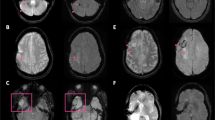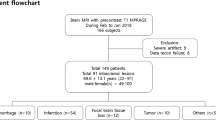Abstract
Background
Ultrafast brain MRI is required for uncooperative patients and time-critical diseases such as stroke because it reduces scan times and motion artifacts. This study investigated the clinical feasibility of a 1-min ultrafast brain MRI protocol for detecting intracranial abnormalities in restless and uncooperative patients.
Methods
We retrospectively reviewed the records of 25 patients who underwent a 1-min ultrafast MRI protocol using T1-weighted image, T2-weighted image, echo-planar fluid-attenuated inversion recovery, diffusion-weighted image, and T2*-weighted image between March 2017 and May 2017. Simple methods were applied for ultrafast MRI protocol to reduce scan time as follows: parallel imaging techniques, multiband technique on diffusion sequence, and echo-planar fluid-attenuated inversion recovery. The images were compared with the routine brain MRI protocol using synthetic MRI, and quality was assessed by two independent readers. The Wilcoxon signed-rank test was used to compare the readers’ ratings of the routine MRI protocol and ultrafast MRI protocol images.
Results
Using a four-point assessment scale, overall image quality and anatomical delineation of ultrafast brain MRI images were lower than those of routine brain MRI images. However, the ultrafast protocol demonstrated sufficient overall image quality and anatomical delineation with an assessment rating greater than two points. The ultrafast protocol had fewer artifacts than the routine protocol using synthetic MRI.
Conclusions
Although the overall image quality and anatomical delineation of the 1-min ultrafast MRI were inferior to those of the routine brain MRI protocol, the ultrafast protocol showed at least sufficient image quality. Therefore, this protocol may be an option in specific clinical situations involving non-cooperative, restless, or pediatric patients, or patients with time-critical disease such as stroke. Further study is required to validate our findings.



Similar content being viewed by others
References
Blystad I, Warntjes JB, Smedby O, Landtblom AM, Lundberg P, Larsson EM (2012) Synthetic MRI of the brain in a clinical setting. Acta Radiol 53:1158–1163
Heidemann RM, Ozsarlak O, Parizel PM, Michiels J, Kiefer B, Jellus V, Müller M, Breuer F, Blaimer M, Griswold MA, Jakob PM (2003) A brief review of parallel magnetic resonance imaging. Eur Radiol 13:2323–2337
Warntjes JB, Leinhard OD, West J, Lundberg P (2008) Rapid magnetic resonance quantification on the brain: optimization for clinical usage. Magn Reson Med 60:320–329
Granberg T, Uppman M, Hashim F, Cananau C, Nordin LE, Shams S, Berglund J, Forslin Y, Aspelin P, Fredrikson S, Kristoffersen-Wiberg M (2016) Clinical feasibility of synthetic MRI in multiple sclerosis: a diagnostic and volumetric validation study. AJNR Am J Neuroradiol 37:1023–1029
Tanenbaum LN, Tsiouris AJ, Johnson AN, Naidich TP, DeLano MC, Melhem ER, Quarterman P, Parameswaran SX, Shankaranarayanan A, Goyen M, Field AS (2017) Synthetic MRI for clinical neuroimaging: results of the magnetic resonance image compilation (MAGiC) prospective, multicenter, multireader trial. AJNR Am J Neuroradiol 38:1103–1110
Betts AM, Leach JL, Jones BV, Zhang B, Serai S (2016) Brain imaging with synthetic MR in children: clinical quality assessment. Neuroradiology 58:1017–1026
Deshmane A, Gulani V, Griswold MA, Seiberlich N (2012) Parallel MR imaging. J Magn Reson Imaging 36:55–72
Gulani V, Schmitt P, Griswold MA, Webb AG, Jakob PM (2004) Towards a single-sequence neurologic magnetic resonance imaging examination: multiple-contrast images from an IR TrueFISP experiment. Investig Radiol 39:767–774
Hagiwara A, Warntjes M, Hori M, Andica C, Nakazawa M, Kumamaru KK, Abe O, Aoki S (2017) SyMRI of the brain: rapid quantification of relaxation rates and proton density, with synthetic MRI, automatic brain segmentation, and myelin measurement. Investig Radiol 52:647–657
Barth M, Breuer F, Koopmans PJ, Norris DG, Poser BA (2016) Simultaneous multislice (SMS) imaging techniques. Magn Reson Med 75:63–81
Prakkamakul S, Witzel T, Huang S, Boulter D, Borja MJ, Schaefer P, Rosen B, Heberlein K, Ratai E, Gonzalez G, Rapalino O (2016) Ultrafast brain MRI: clinical deployment and comparison to conventional brain MRI at 3 T. J Neuroimaging 26:503–510
Fagundes J, Longo MG, Huang SY, Rosen BR, Witzel T, Heberlein K, Gonzalez RG, Schaefer P, Rapalino O (2017) Diagnostic performance of a 10-minute gadolinium-enhanced brain MRI protocol compared with the standard clinical protocol for detection of intracranial enhancing lesions. AJNR Am J Neuroradiol 38:1689–1694
U-King-Im JM, Trivedi RA, Graves MJ, Harkness K, Eales H, Joubert I, Koo B, Antoun N, Warburton EA, Gillard JH, Baron JC (2005) Utility of an ultrafast magnetic resonance imaging protocol in recent and semi-recent strokes. J Neurol Neurosurg Psychiatry 76:1002–1005
Nael K, Khan R, Choudhary G, Meshksar A, Villablanca P, Tay J, Drake K, Coull BM, Kidwell CS (2014) Six-minute magnetic resonance imaging protocol for evaluation of acute ischemic stroke: pushing the boundaries. Stroke 45:1985–1991
Patel DM, Tubbs RS, Pate G, Johnston JM Jr, Blount JP (2014) Fast-sequence MRI studies for surveillance imaging in pediatric hydrocephalus. J Neurosurg Pediatr 13:440–447
Likert R (1932) A technique for the measurement of attitudes. Arch Psychol 22:1–55
Skare S, Sprenger T, Norbeck O, Rydén H, Blomberg L, Avventi E, Engström M (2018) A 1-minute full brain MR exam using a multicontrast EPI sequence. Magn Reson Med 79:3045–3054
Tomura N, Kato K, Takahashi S, Sashi R, Izumi J, Narita K, Watarai J (2002) Multi-shot echo-planar Flair imaging of brain tumors: comparison of spin-echo T1-weighted, fast spin-echo T2-weighted, and fast spin-echo Flair imaging. Comput Med Imaging Gr 26:65–72
Korogi Y, Sugahara T, Shigematsu Y, Ikushima I, Hirai T, Okuda T, Takahashi M (1999) Ultrafast FLAIR imaging with single-shot echo-planar technique in evaluation of intracranial lesions. Comput Med Imaging Gr 23:119–126
Pruessmann KP (2004) Parallel imaging at high field strength: synergies and joint potential. Top Magn Reson Imaging 15:237–244
Wiesinger F, Van de Moortele PF, Adriany G, De Zanche N, Ugurbil K, Pruessmann KP (2006) Potential and feasibility of parallel MRI at high field. NMR Biomed 19:368–378
Viera AJ, Garrett JM (2005) Understanding interobserver agreement: the kappa statistic. Fam Med 37:360–363
Feinstein AR, Cicchetti DV (1990) High agreement but low kappa: I. The problems of two paradoxes. J Clin Epidemiol 43:543–549
Author information
Authors and Affiliations
Corresponding authors
Ethics declarations
Conflicts of interest
The authors declare that they have no conflicts of interest.
Ethical standards
All procedures performed in studies involving human participants were in accordance with the ethical standards of the institutional and/or national research committee and with the 1964 Helsinki declaration and its later amendments or comparable ethical standards.
Rights and permissions
About this article
Cite this article
Ryu, K.H., Choi, D.S., Baek, H.J. et al. Clinical feasibility of 1-min ultrafast brain MRI compared with routine brain MRI using synthetic MRI: a single center pilot study. J Neurol 266, 431–439 (2019). https://doi.org/10.1007/s00415-018-9149-4
Received:
Revised:
Accepted:
Published:
Issue Date:
DOI: https://doi.org/10.1007/s00415-018-9149-4




